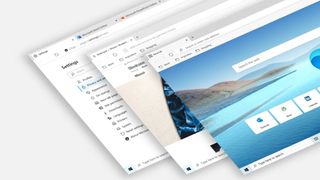Working from home? Microsoft just gave you a good reason to ditch Google Chrome
Microsoft enhances malicious site blocking and profiles

After years of ridicule for Internet Explorer and a lukewarm reception to the initial version of Edge, Microsoft is eager for the new Chromium-based version of Edge to be taken seriously. To this end, the company has been busily adding features and options, and the latest additions are focused on security and making it easier to work from home.
The first change relates to the browser's Profiles feature, and it comes as great news for anyone who is using Edge to bounce between browsing the internet for fun and using it for work. Microsoft has made it easier to create and switch between profiles so you can keep your work and personal life separate.
With Edge 83, Microsoft has not only made it easy to create profile, but has made various enhancements to the feature. Once you have created a work and personal profile – just click your profile icon to the upper right of the browser window and select Add a profile This same menu can then be used to switch between profiles.
Desktop shortcuts to each profile are automatically created so you can easily jump into the one you need to use at any given time. However, Microsoft has also introduced automatic profile switching. While not particularly useful for when you're working from home, if you take your laptop from home to the office, Edge will automatically detect that you're in a different location and load the relevant profile for you.
Safe and sound
Microsoft has also made some important security changes to Edge to make it a safer option for browsing the internet, whether for work or pleasure. Currently only available to beta tester on the Edge Insider program, version 84 of the browser includes changes to the SmartScreen security feature which blocks malicious sites and downloads.
The changes mean that Edge (specifically Microsoft Edge Dev v 84.0.495.2) now blocks apps that are downloaded as ClickOnce or DirectInvoke apps -- techniques used to download and run apps with minimal user interaction. By blocking more suspicious and potentially malicious apps in this way, Microsoft is placing a serious emphasis on security and getting ready to take on the likes of Chrome.
Via Forbes
Get daily insight, inspiration and deals in your inbox
Get the hottest deals available in your inbox plus news, reviews, opinion, analysis and more from the TechRadar team.

Sofia is a tech journalist who's been writing about software, hardware and the web for nearly 25 years – but still looks as youthful as ever! After years writing for magazines, her life moved online and remains fueled by technology, music and nature.
Having written for websites and magazines since 2000, producing a wide range of reviews, guides, tutorials, brochures, newsletters and more, she continues to write for diverse audiences, from computing newbies to advanced users and business clients. Always willing to try something new, she loves sharing new discoveries with others.
Sofia lives and breathes Windows, Android, iOS, macOS and just about anything with a power button, but her particular areas of interest include security, tweaking and privacy. Her other loves include walking, music, her two Malamutes and, of course, her wife and daughter.
Most Popular

